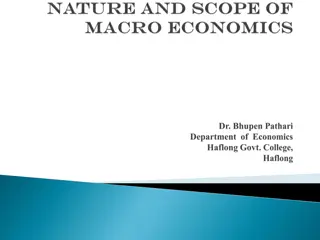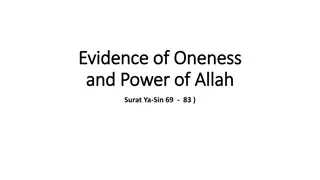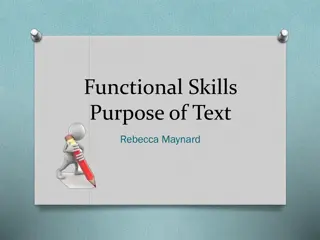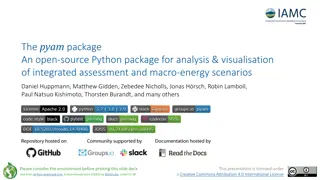Analysis of Quranic Macro Text Features and Occurrences
This detailed analysis delves into the various features and occurrences of macro text in the Quran, exploring different types of Quranic sentences, repetitions, formulas, epithets, leitmotifs, parables, premises, deductive arguments, and more. The study also examines thematic coherence, mutashabihat, and relevance-based lexical items in Quranic macro text.
Download Presentation

Please find below an Image/Link to download the presentation.
The content on the website is provided AS IS for your information and personal use only. It may not be sold, licensed, or shared on other websites without obtaining consent from the author.If you encounter any issues during the download, it is possible that the publisher has removed the file from their server.
You are allowed to download the files provided on this website for personal or commercial use, subject to the condition that they are used lawfully. All files are the property of their respective owners.
The content on the website is provided AS IS for your information and personal use only. It may not be sold, licensed, or shared on other websites without obtaining consent from the author.
E N D
Presentation Transcript
Quranic Macro Text By Ibrahim Talaat Ibrahim
Outline Introduction 1.Macro Text Features Occurrence 2. Types of Quranic Sentence Occurrence Examples about sentence Occurrence 3. Macro Text Synonyms 4. Macro Text Repetition 4.1. Repetition of Content Words 4.2. Repetition of Function Words 4.1.1. Examples about Repetition of Content Words 4.2. Repetition of Function Words 4.2.1. Examples about Repetition of Function Words 5.Macro Text Formulas 6.Macro Text Epithets 7.Macro Text Leitmotifs 7.1. Examples about Macro Text Leitmotifs 8.Macro Text Parables 8.1.Examples about Parables 9. Macro Text Premise and Rebuttal 9.1.Examples about Premises 10. Macro Text Deductive Argument 10.1. Example about Macro Deductive Argument 11.Macro Text Shift in the Glorious Qur'an 12. Macro Text Noun-initial Sentences (Aya) 13. Macro Text Mutashabihat 13.1. Examples about Macro Text Mutashabihat 14. Macro Text Thematic Coherence Surat AL-Ikhlas Textual Analysis 15. Macro Text Relevance-Based Lexical Item 15.1. Examples about Macro Text Relevance-Based Lexical Item Conclusion References
2. Types of Quranic Sentence Occurrence
Examples about sentence Occurrence 2.1. Occurrence of Sentences once Qur an, as in sentence 89 of (Surat Taha), which is the only sentence in the Qur an that starts with the interrogative phrase (afal they not see?). Sentence 95 of (Surat AL-Anbiya) is the only sentence in the Qur an which starts with the verb (wa ar mun and there is prohibition). yarawna did
Examples about sentence Occurrence 2.2. Occurrence of Sentences twice There are sentences that have occurred only twice in the Qur an, as in sentences (Surat AL-Baqara: 274 275) in which the relative pro- noun (alladh na those who) occurs in sentence-initial position in sentences immediately after each other only twice in the Qur an. The pronoun (huwa He (God)) occurs in sentence- initial position in sentences immediately after other only twice in the Qur an, as in (Surat AL-Imran: 6-7). each
Examples about sentence Occurrence 2.3. Occurrence of Formulas twice Occurrence of formulas twice: The phrase formula (inna lil-muttaq na indeed, for the righteous) occurs sentence-initially only twice in the Qur an, as in (Surat AL-Qalam:24) and (SuratAL-Naba':31).
Examples about sentence Occurrence 2.4. Occurrence of Syntactic Patterns twice The syntactic structure: inna + subject noun (inna rabbakum all hu Indeed, your Lord is God) occurs in sentence-initial position only twice in the Qur an, as in (Surat AL-A'raf:54) and (Surat Yunis: 3).
Examples about sentence Occurrence 2.5. Occurrence of Lexical Items or Sentences three times The masculine plural active participle noun (s il n the needy petitioners) occurs only three times in the Qur an, as in (Surat AL-Baqara: 177), (Surat Yusif: 7), and (Surat Fusilat: 10). There are only three sentences in the Qur an which occur consecutively with the initial vocative word (rabban our Lord): (Surat AL-Imran: 192-194).
Examples about sentence Occurrence 2.6. Occurrence of Lexical Items or Sentences four times The masculine singular active participle noun (s il the needy petitioner) occurs only four times Qur an, as in (Surat Adh-Dhaariyat: 19), (Surat AL- Ma'arij: 1 and 25) and (Ad-Dhuhaa:10). There are only four sentences in the Qur an which occur with an initial third person mas- culine plural pronoun (hum they): (Surat AL-Imran: 163), (Surat Yaseen: 56), (Surat AL- Fath: 25) and (SuratAL-Munaafiqoon: 7). in the
3. Macro Text Synonyms They are defined as semantic macro text feature of Qur'anic discourse. The following are many examples taken from the Glorious Qur'an (yawm al-d n the day of recompense) (Surat AL-Fatiha: 4) (al-yawm al- khir the last day) (Surat AL-Baqara: 177) (yawm al-bacth the day of resurrection) (SuratAr-room) (yawm al-khul d the day of eternity) (Surat Qaaf: 34) (al-gh shiyah the (day of) overwhelming event) (Surat AL- Ghaashiya:1)
4.1.1. Examples about Repetition of Content Words 12 ) ( 13 ( ) ( 15 ) ( 14 ) ( 16 ) (Surat AL-A'raf) God) said: What prevented you from prostrating . . . , (Satan) said: I am betterthan him (Adam) . . . , (God) said: Descend from it (paradise) . . . , (Satan) said: Reprieve me until the day they are resurrected . (God) said: Indeed, you are of those reprieved . (Satan) said: Because You (God) have put me in error, I will surely sit in wait for them . . . The verb said repeated six times as explained above in the Qur'anic Sura whose name is (AL-A'raf)
4.2. Repetition of Function Words The Arabic language also consists of certain elements called (function words). In other words, these words can function in the body of the text and can be of great importance in context but it cannot stand alone because they don't have concrete meaning and they have abstract one only. The diagram designed below explains types of function words found in Arabic in general and the Glorious Qur'an in particular.
4.2.1. Examples about Repetition of Function Words 6 ( ( ) 7 ) (Surat AL-Imran) It is He (God) who forms you in the wombs . . ., It is He (God) who has sent down to you (Mu ammad) the Book The function word (relative pronoun He in the Qur'anic excerpt above, both of the occurrences refer to AL-Mighty Allah the God of Universe. Therefore, they have been capitalized . the word ) ) cannot stand alone unless it is inserted in a text to be meaningful. ) is mentioned twice
5.Macro Text Formulas They are described as fixed (frozen) expression that occur consecutively in the Qur'anic Macro text. There are many examples, however, one major Qur'anic formulas is highlighted below: ( 163 (Surat AL-Baqara) ) 22 (Surat ) ( AL-Nahil) ( 110 ) (Surat AL-Kahif) ( 108 (Surat AL-Anbiya) ) ( 34 ) (Surat AL-Hajj) It is translated into English : "Your God is one God"
6.Macro Text Epithets The Qur'anic macro text is featured by the recurrent reference of epithet couplets. To prove the recurrence of such feature, many examples are highlighted below: (the entirely merciful, the especially merciful) (the forgiving, the merciful) (the knowing, the wise) (the exalted in might, the merciful) (the exalted in might, the wise) There couplets are mentioned repeatedly in almost all the Qur'anic Suras.
7.Macro Text Leitmotifs The Qur'anic macro text is also marked by particular sentences whose structural and stylistic features are different but their thematic and conceptual ones are similar . Yet, they are intertextually related to one another.
7.1. Examples about Macro Text Leitmotifs ( 151 ) (Surat AL-An'am) English Translation: "Don't kill your children out of poverty. We (God) will provide for you and them." 31 ) ( (Surat AL-Israa) English Translation: "Don't kill your children for fear of poverty. We (God) will provide for them and for you" The underlined expression in the abovementioned Qur'anic Ayas of different Suras is repeated in different styles. However, they are intertextually related to the same theme of (killing own children)
8.Macro Text Parables The Qur'anic parables are featured by the followings: 1-They are available in different Suras and Ayas 2- Their lengths are variable. 3-Their styles are different and themes are similar. 4-Their functions on intertextuality and cohesion the macro level:
8.1.Examples about Parables There are many examples about parables in the Glorious Qur'an. Yet, (Surat Yousif) is the best example where the story of prophet Yousif is mentioned in different styles in the body of the sura. However, they contribute towards making the main theme of his character cohesive.
9. Macro Text Premise and Rebuttal The Qur'anic macro texts highlight two significant parts. They are Good (Protagonist: Almighty Allah ) and Evil (Devil). This is why, there are argument between AL-Mighty Allah and Evil and these argumentations are functioned by God Great Power. It is worth noting that there many premises in the Glorious Qur'an such as: monotheism and resurrection. Al-mighty Allah premises of the said points are highlighted but Evil oppose them. Therefore, Al-mighty Allah makes use of his great power to substantiate these matters.
9.1.Examples about Premises ( 91 ) (Surat AL-Mu'minoon) English Translation: God has not taken any son, nor has there ever been with Him any deity ( 91 ) Substantiation to premise: it is found in the same Aya as mentioned below: English Translation :If there had been, then each deity would have taken what it created, and some of them would have sought to overcome others
10. Macro Text Deductive Argument The deductive argument (reasoning scheme) is a major Qur anic macro text feature. Throughout the Qur an, we encounter God s omnipotence details deductive argument reader/listener is persuaded and enabled to reach a conclusion that supports God s premise, as in the following example: functioning through as a which the
10.1. Example about Macro Deductive Argument 3 ) ( (Surat AL-Nahil) The abovementioned Aya is a sign out of twelve signs cited in the Sura in question to show people who read the Glorious Qur'anic Al- Mighty Allah absolute power. In other words, such ayas send convincing message to people all over the globe that Almighty Allah is worth worshipping.
12. Macro Text Noun-initial Sentences (Aya) It is concerned with the Qur'anic nouns like Al-mighty Allah's name placed at the a beginning of the Qur'anic Aya. They are transposed to the beginning due to the following functions: 1-Substantiating Allah's great power. 2-Shedding lights on Allah's blessings. 12.1. Examples about Macro Text Initial Sentences (Aya) ( 2 ) (Surat AL-R'ad) English Translation: God is the one who erected the heavens without pillars that you can see
13. Macro Text Mutashabihat Al-Mutashabihat constructions are defined as expressions found in the body of the Glorious Qur'an, they are stylistically different from each other but thematically and grammatically similar to one another. In other words, they are related intertextually due to the shared (theme)
13.1. Examples about Macro Text Mutashabihat 62 ) ( )Surat AL-Hajj) English Translation:That is because God is indeed the truth, and that which they call upon other than Him is indeed false- hood, and because God is the most high, the grand 30 ) ( (Surat Luqman) English Translation:That is because God is indeed the truth, and that which they call upon other than Him is falsehood, and because God is the most high, the grand The themes of both Ayas are about monotheism. In other words, they are thematically similar. But, they are different on the stylistic level because the first Aya consists of two third person pronoun () while the second one embraces one () only. It lirerally means (he). This is not the case in the aforementioned aya (62) because it refers to (indeed it is, surely). This means that () in the first Aya has a pragmatic function.
14. Macro Text Thematic Coherence At the Qur anic macro text, the tenets of faith ( ) occur in a coherent manner. There are four major tenets of faith: monotheism (), prophet-hood (), eschatology (), and reward and punishment (). In between these tenets of faith, we may encounter other themes like God s omnipotence (), admonition for morality (), or Islamic legal rulings ().
Surat AL-Ikhlas Textual Analysis The researcher selected (Surat AL-Ikhlas) to carry out the textual analysis and underline the tenets of faith: 4 3 2 1 ) ( ) ( ) ( ) ( English Translation In the name of Allah, the Most Compassionate, the Most Merciful 1-Say (O Mohammad (PBUH) He is Allah, the One 2- Allah's Us-Samad (The Self-Sufficient Master, Whom all creatures need, He neither eats nor drinks). 3-He begets not, nor was He begotten. 4-And there is none co-equal or comparable unto him. There are two significant tenets highlighted in the Sura above: the first tenet is prophet-hood as in the first Aya (Say (O Mohammad (PBUH) He is Allah, the One) and the second one is concerned with monotheism as in the third Aya (He begets not, nor was He begotten.). it is worth mentioning that there is a theme of omnipotence as in the fourth Aya (And there is none co-equal or comparable unto him).
15. Macro Text Relevance-Based Lexical Item The semantic macro text feature that recurrently occurs in the Glorious Qur an. It deals the occurrence of a specific word due to its relevance and through which coherence and continuity of thought are achieved. Relevance-Based Lexical Item is a
15.1. Examples about Macro Text Relevance-Based Lexical Item ( 65 ) (Surat AL-Nahil) English Translation: God sends down rain from the sky and gives therewith life to the earth after its death; verily in this is a sign for those who listen Why Al-mighty Allah chose the verb ( listen) in the Aya cited above instead of (see)? Does this choice relevant? To answer the questions highlighted above, the researcher has to dig in-depth of the context of the Qur'anic Macro text to understand the whole theme: the major problem with pagan Arabs was that they were arrogant, worshiping different deities and they do not believe in Allah. The choice of the Qur'anic verb () is the most appropriate option and relevant one because the Aya (65) put forward to Pagan Arabs to listen. In other words, if they listen to the Aya and look at the sky and how the rain fall they will astonished by the God (Al-mighty Allah's miracle).
Conclusion It is concluded that Qur'anic Macro text is concerned with the Qur'anic text as a whole. The ultimate goal behind the analysis of the Quranic macro text is presented as follows: Grasping the components of the Qur'anic Marco text as they were explained in the diagrams presented in the PowerPoint. Helping researchers link the dots and make sense of the structures of the Glorious Qur'an because there are many different structures of many Qur'anic Ayas but their themes and grammar are similar. Shedding lights on the importance of the theme and the tenets of faith which are defined as the corner stone of Islam. Comprehending the significance of shifts in the Glorious. All the above mentioned points also contribute to widening the understanding of translators who deal with the Glorious Quran. In other words, if translators understand the elements of the Quranic Macro text well, they are expected to produce something appropriate in the target language.
References The Glorious Qur'an Abdul Raof, Hussein. (2019). Text Linguistics of Qur'anic Discourse Routledge Publishing House Al-Hilali and Khan ( nodate ) Interpretation of the Meanings of the Noble Qur an (online ) , available :,.http://www.quranbrowser.com/cgi/bin/get.cgi An Aanlysis. London:























